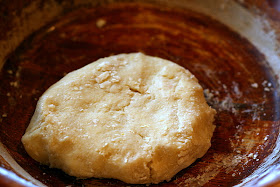The 2010 November Daring Bakers’ challenge was hosted by Simona of briciole. She chose to challenge Daring Bakers’ to make pasta frolla for a crostata. She used her own experience as a source, as well as information from Pellegrino Artusi’s Science in the Kitchen and the Art of Eating Well.
I am late with my Daring Bakers Challenge post this month; throwing a birthday party and Thanksgiving cooking left me with little time to post on the 27th. I finally had time to finish it though, and the challenge this month was another opportunity for to me to try something new and fun. Crostata (tart) is an Italian dessert, with a base of pasta frolla (sweet short crust pastry) and can be filled with whatever you please. Since Thanksgiving was just around the corner, I thought to do a pumpkin filled tart, but I had some pomegranates sitting in my refrigerator and decided to whip up this Orange Pomegranate Tart. I love pomegranates and it's definitely a bonus that they are so good for you!
I have never made pastry cream before, so this was an opportunity for me to gain some experience in something new, and while the pastry cream was good, I think next time I would try an orange curd. I did not have a large tart pan, so I made little tartlets, then filled them with the orange pastry cream and sprinkled with pomegranate arils. I always like to make mini sized desserts, it tricks my brain into thinking that I'm eating an acceptable amount of calories...never mind that I usually eat two of them:)
Orange Pomegranate Tart
Printable Recipes
Orange Pastry Cream
1 cup milk
1/4 cup sugar
finely grated peel from one orange
1/8 teaspoon vanilla (optional)
3 large egg yolks
2 tablespoons all-purpose flour
1 tablespoon unsalted butter, room temperature
In a small bowl, whisk the egg yolks together with 2 tablespoons of the sugar, and the flour until well incorporated. Set aside. In a small, heavy-bottomed pan, place the milk, orange zest, and the other 2 tablespoons of sugar, and heat until barely boiling. Remove from heat and pour half of the milk mixture into the yolk mixture, whisking until combined. Pour the egg mixture back into the saucepan and put on medium-low heat, whisking constantly until mixture is thick (about 2-3 minutes). Remove from heat and add the butter, stirring until melted. If desired, press the pastry cream through a sieve over a bowl. Store in the refrigerator with plastic wrap pressed on the surface for up to 3 days.
Pasta Frolla (sweet short crust)
1/2 c. minus 1 tablespoon superfine sugar, or a scant 3/4 cup of powdered sugar
1 and 3/4 cup unbleached all-purpose flour
a pinch of salt
1 stick cold unsalted butter, cut into small pieces
grated zest of half a lemon
1 large egg and 1 large egg yolk, lightly beaten in a small bowl
In a large bowl, whisk together sugar, flour and salt. Rub or cut the butter into the flour until the mixture has the consistency of coarse crumbs. You can do this in the bowl or on your work surface, using your fingertips or a fork.
Make a well in the center of the mounded flour and butter mixture and pour the beaten eggs into it. Add the lemon zest to your flour/butter/egg mixture. Use a fork to incorporate the liquid into the solid ingredients, and then use your fingertips. Knead lightly just until the dough comes together into a ball.
Shape the dough into a flat disk and wrap in plastic wrap. Place the dough in the refrigerator and chill for at least two hours. You can also refrigerate the dough overnight.
Heat the oven to 350F. Take the pasta frolla out of the fridge, unwrap it, but keep the dough loosely covered. Roll the crostata dough out between the plastic wrap, this prevents the dough from sticking to your surface without using flour, and makes it easier to transfer to your tart pan.
If the dough is very firm, start by pressing the dough with the rolling pin from the middle to each end, moving the rolling pin by a pin's width each time; turn the dough 180 degrees and repeat; when it softens, start rolling. Roll the dough into a circle about 1/8th inch thick. Now flip the dough over the pan, centering it, and delicately press it all around so the corners are well covered. Peel away the plastic wrap. Trim the excess dough hanging over the edges of the pan. Press the remaining dough around the border into the sides of the pan making sure the border is an even thickness all the way around.
Remove the crostata shell from the tart pan, and place on a serving plate. Fill the cooled shell with the prepared pastry cream, then sprinkle the pomegranate arils over the top. Enjoy!
Amber














